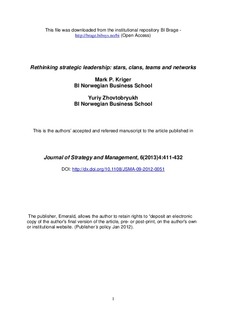Rethinking strategic leadership: stars, clans, teams and networks
Journal article, Peer reviewed
Permanent lenke
http://hdl.handle.net/11250/93982Utgivelsesdato
2013Metadata
Vis full innførselSamlinger
- Scientific articles [2181]
Originalversjon
http://dx.doi.org/10.1108/JSMA-09-2012-0051Sammendrag
Purpose: Most of the thousands of studies of leadership as well as strategic leadership in organizations choose as the unit of analysis the individual leader. This choice runs contrary to the often-observed fact that organizations have numerous leaders at all levels of the organization - in other words, a network of leaders, which permeates the formal organizational structure. This paper aims to reconceptualise strategic leadership by advancing understanding of: 1) the effects of variations in internal complexity and external turbulence and 2) the effects of choices by the strategic leadership based on those variations.
Design/methodology/approach: This paper advocates a network approach to strategic leadership where there is a set of highly dynamic role changes, based on both human and social capital. The typology and propositions in the paper emerged over a period of many years of observation of organizations (direct and indirect) as well as reflection of theories on how strategic leadership actually occurs in medium to large-size profit-oriented organizations.
Findings: This paper proposes a model of strategic leadership based upon four modes of single actor and shared leadership (stars, clans, teams and leadership networks). It sets forth propositions for the situational appropriateness of each of these four forms and identifies avenues for future research to advance the theory.
Originality/value: This paper cross-fertilizes extant research streams in leadership and strategic management to create a contingency theory of strategic leadership that is closer to what executives actually experience in the workplace.
Beskrivelse
This is the authors’ accepted and refereed manuscript to the article
